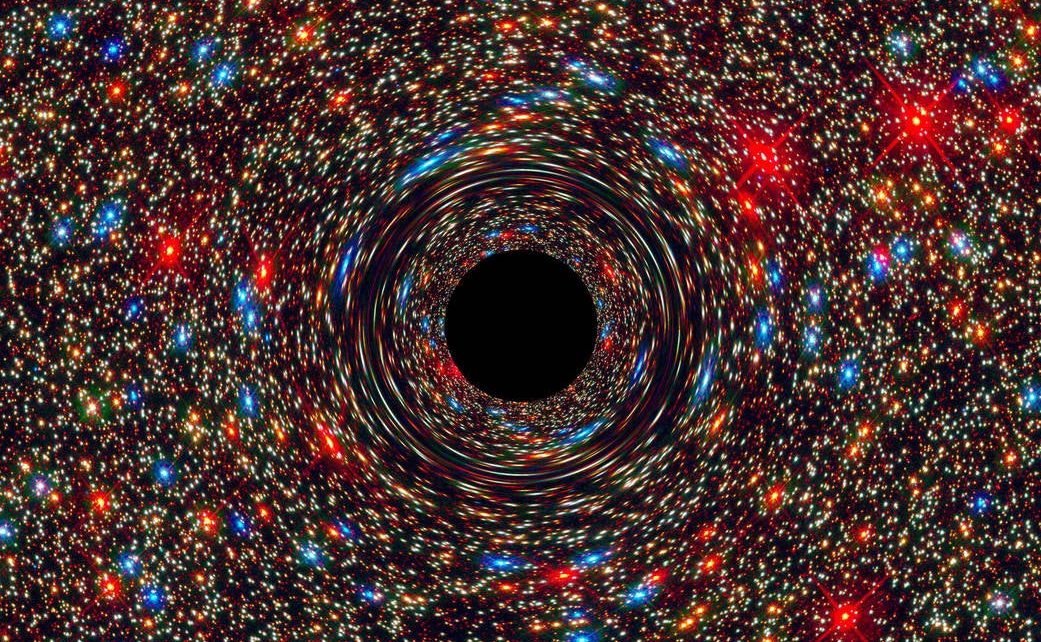Black holes are hidden behind event horizons, and just as in Las Vegas, “whatever happens inside the horizon, stays inside the horizon.” No information leaks out.
A black hole horizon brings the added benefit of hiding an embarrassment of the theory that predicts it. Matter falling into a black hole ends up in a singularity where the curvature of spacetime diverges and Einstein’s equations of general relativity break down. Fortunately, our inability to determine the whereabouts of infalling matter as its density diverges near this singularity has no influence on the outside world, which remains protected by the horizon.
But can Einstein’s equations give rise to “naked singularities,” which are not hidden behind a horizon? If such regions of spacetime affect us, we would not be able to predict our future using general relativity.
To avoid such a crisis, the physicist Roger Penrose postulated in 1969 the cosmic censorship hypothesis, which conjectures that there might be constraints prohibiting naked singularities in nature. If so, general relativity has a way of maintaining determinism by capping the influence of regions whose future behavior cannot be forecasted.
But is there really a need for cosmic censorship? We know that Einstein’s equations of general relativity are incomplete because they are missing a crucial element of modern physics, namely quantum mechanics. A complete theory of quantum gravity, which we currently do not have, might cure singularities and allow the usual determinism to manifest itself throughout the entirety of spacetime. In that theory, there would be no need to censor any region through restrictions that go beyond fundamental physical principles.
In fact, we already have a strong hint that this might be the case. In 1974, Stephen Hawking showed that black holes radiate. In retrospect, his result is obvious. There is no way to confine particles of light, photons, in a prison cell that is smaller than their wavelength, since their position cannot be localized to that precision. As a result, vacuum fluctuations near a black hole produce photons that leak out because their wavelength is larger than the horizon scale. This so-called “Hawking radiation” is enabled by the gravitational binding energy of virtual particles that end inside the black hole.
Evaporating black holes are naked singularities since they are not fully concealed by their event horizon. Unfortunately, the radiation is too weak to be detectable for astrophysical black holes more massive than three suns with horizon size bigger than the length of Manhattan. Asteroid-mass black holes, which might have been produced in the early universe, possess a horizon smaller than the size of a proton and could have exploded over the age of the universe. Although we have not detected evaporating black holes so far, they are predicted by the simple semiclassical formulation of quantum gravity.
Despite this well-known example, mathematicians and philosophers still argue whether cosmic censorship should limit the scope of “reasonable” spacetimes in general relativity. In parallel, computer codes are being used to solve Einstein’s equations and search for pathological naked singularities under extreme conditions.
In a recent colloquium at Harvard’s Black Hole Initiative, a philosopher defined cosmic censorship as one of the most stimulating questions in current studies of general relativity. When he finished the lecture, I had only one question: “Keeping in mind these mathematical and philosophical considerations, astronomers could search for naked singularities in the sky. If we find them, would there be any need for censorship?”
Instead of finding reasons to avoid naked singularities, we should cherish the opportunity to find them as a path for exploring new physics. Of course, the crucial unknown in this regard is: “What do naked singularities look like?” Owing to the extreme curvature of spacetime in their vicinity, naked singularities might produce high-energy particles in a powerful fireball of energy. Do we observe such fireballs on the sky? Is it possible that we have already detected naked singularities but misinterpreted their nature?
One family of documented fireballs is gamma-ray bursts. These astrophysical blasts are commonly associated with the birth of black holes or collision of neutron stars but not with naked singularities. We also observe fast radio bursts whose nature is unknown as of yet.
We should keep our eyes open. If detected by our telescopes, naked singularities would be the best laboratories for testing theories of quantum gravity, such as string theory. The problem is that candidate theories of quantum gravity do not predict how such sources would look like. They have no “skin in this game.” Hence, observers should lead the way, including through the challenging pursuit of gravitational waves from the big bang singularity.



